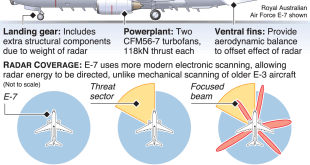China’s Tiangong space station, also known as the Heavenly Palace, is a testament to the country’s remarkable strides in space exploration and technological advancement. As the third space station to orbit Earth, following the Mir and International Space Station (ISS), Tiangong represents a significant milestone in China’s space ambitions and its growing role in global space cooperation.
Construction and Significance
China Is Now a Major Space Power. Tiangong’s construction began in April 2021 with the launch of the Tianhe core module, which serves as the station’s control center, living space, and scientific research hub. Over the next year and a half, two additional modules, Wentian and Mengtian, were successfully launched and attached to the core module, completing the station’s T-shape configuration. With the Tiangong station’s completion, the country has a long-term platform in orbit. On October 31, China launched the final piece of its new Tiangong space station, completing its construction.
The existing Tiangong space station, operational since late 2022, consists of three modules: the Tianhe core module, the Wentian science module, and the Mengtian module, each serving distinct functions in supporting crew members, conducting experiments, and advancing scientific research.
Tiangong’s significance extends beyond its physical structure. It represents China’s ability to independently design, develop, and construct a large-scale space station, demonstrating the country’s mastery of complex aerospace technologies. The station’s operation also showcases China’s advanced capabilities in spaceflight management, life support systems, and scientific research.
The International Space Station won’t run for much longer. You may well end up with only one orbiting space station—the Chinese one,” says Fabio Tronchetti, a space law professor at Beihang University in Beijing and the University of Mississippi. The much larger ISS, operated by the United States, the European Space Agency, Russia, and other partners, could be retired as soon as 2030—that’s the end date the Biden administration gave it after extending its mission last year
Cutting-Edge Technology:
Tiangong officially the Tiangong space station, is a space station constructed by China and operated by China Manned Space Agency (CMSA) in low Earth orbit between 340 and 450 km (210 and 280 mi) above the surface.
Being China’s first long-term space station and the core of the “Third Step” of the China Manned Space Program (CMS), it has a mass between 90 and 100 t (200,000 and 220,000 lb), roughly one-fifth the mass of the International Space Station and about the size of the decommissioned Russian Mir space station.
Tiangong is equipped with state-of-the-art technology, including advanced life support systems, autonomous cargo and fuel supply capabilities, and sophisticated scientific instruments. These technological features not only ensure the well-being of astronauts during extended missions but also enable a diverse range of experiments and studies in the unique microgravity environment of space.
Structure
The space station is a third-generation modular space station. First-generation space stations, such as early Salyut, Almaz, and Skylab, were single-piece stations and not designed for resupply. Second-generation Salyut 6 and 7, and Tiangong 1 and 2 stations, are designed for mid-mission resupply. Third-generation stations, such as Mir and the International Space Station, are modular space stations, assembled in orbit from pieces launched separately. Modular design can greatly improve reliability, reduce costs, shorten development cycles, and meet diversified task requirements.
The first module, the Tianhe (“Harmony of the Heavens”) core module, was launched on 29 April 2021, followed by multiple crewed and uncrewed missions and two more laboratory cabin modules Wentian (“Quest for the Heavens”) launched on 24 July 2022 and Mengtian (“Dreaming of the Heavens”) launched on 31 October 2022. The research conducted on the station aims to improve researchers’ ability to conduct science experiments in space.
But although it’s smaller than the ISS, says Jan Osburg, an aerospace engineer at the Rand Corporation, “on the inside they have some creature comfort features that improve habitability and therefore astronaut productivity: less clutter, more wireless rather than cabling, and a microwave in space.”
The real-time communications, including live audio and video links, are provided by the Tianlian II series of data relay satellites. A constellation of three satellites was launched into geostationary orbits, providing communication and data support for the station.
China successfully launched its cargo spacecraft Tianzhou-5 in November 2022 to deliver supplies for its space station, the construction of which is expected to be completed this year. The cargo craft is expected to conduct a fast-automated rendezvous and docking with the space station combination.
Scientific Objectives:
The 18-meter lab module, named Mengtian (meaning “dreaming of the heavens”), enables a range of scientific experiments and now allows the station to accommodate up to six people at a time. It currently hosts commander Chen Dong and two other astronauts.
Tiangong serves as a platform for conducting a wide range of scientific experiments and research in various fields, including space medicine, materials science, and astronomy. The station’s microgravity environment provides unique conditions for studying the effects of long-term space exposure on human physiology and the behavior of materials.
The primary objective of Tiangong is to conduct scientific research that benefits both space exploration and life on Earth. Experiments in fluid physics, materials science, biology, and astronomy are underway, providing valuable insights that would be unattainable on our planet. The space station serves as a platform for understanding fundamental scientific principles and testing technologies crucial for future deep-space exploration.
According to CMSA, which operates the space station, the purpose and mission of Tiangong is to develop and gain experience in spacecraft rendezvous technology, permanent human operations in orbit, long-term autonomous spaceflight of the space station, regenerative life support technology and autonomous cargo and fuel supply technology. It will also serve the platform for the next-generation orbit transportation vehicles, scientific and practical applications at large-scale in orbit, and technology for future deep space exploration.
CMSA also encourages commercial activities led by the private sector and hopes their involvement could bring cost-effective aerospace innovations. Space tourism at the space station is also considered.
Human Presence in Space:
Tiangong is not just a collection of modules and scientific instruments; it represents a continuous human presence in space. Chinese astronauts, also known as taikonauts, reside aboard the station for extended periods, conducting experiments, performing maintenance, and adapting to the challenges of living and working in a confined, weightless environment. This experience is invaluable for preparing humanity for longer-duration space missions, including future voyages to the Moon and Mars.
International Collaboration
In addition to its domestic scientific pursuits, China has also opened up Tiangong for international collaboration. In 2022, China signed an agreement with the United Nations Office for Outer Space Affairs (UNOOSA) to provide opportunities for scientists from around the world to conduct research on the station. This move signals China’s willingness to share its space infrastructure and expertise with the global community.
Military impact
The Chinese Space Station (CSS), has been a talking point in the US military circles and the scientific community. In January 2022, with its massive robotic arm, the Chinese space station successfully grasped and transferred a cargo spacecraft. The 47-minute maneuver was the first test of Tiangong’s 10-metre (33-foot) robotic arm.
“The mission proved the mechanical arm’s ability to handle high loads and assessed the feasibility and effectiveness of using it to maneuver a portion of the space station while in orbit.
According to China Manned Space Programme, Tiangong’s robotic arm is capable of lifting objects weighing up to 20 tonnes and can move about outside the station. In September 2021, the cargo spacecraft Tianzhou 2 performed an automatic release and re-dock at the Tianhe core module. However, it was the first time when it was moved around using the robotic arm.
With a larger door, Mengtian is capable of releasing miniaturised satellites into space. “Astronauts can install the small satellites on a payload transfer device, depressurise the airlock cabin, and then convey them out of the cabin,” said Meng Yao, a designer of Mengtian. “The robotic arm outside the space station will grab the satellites and then catapult them in specified directions,” Meng was quoted as saying by Xinhua news agency.
The Chinese astronauts had also gone on spacewalks after the core module Tianhe was launched into orbit in April last year to work on the robotic arm and guarantee that it was operational.
Smaller versions of Tiangong’s robotic arm have been installed on China’s “scavenger satellites” to collect and direct space debris so that it can burn up in the Earth’s atmosphere. China has launched several scavenger satellites over the last decade.
Earlier, James Dickinson, Commander of the US Space Command, had told a Congressional hearing that the technology “could be used in a future system for grappling other satellites”.
Future Plans and Implications
China’s plans for Tiangong extend beyond its current configuration. The country is considering expanding the station with additional modules, including a robotic arm for maintenance and scientific tasks. China is also exploring the possibility of establishing a lunar outpost in collaboration with international partners.
China is poised to significantly expand its Tiangong space station by incorporating three additional modules, as revealed at the 47th International Astronautical Congress. Zhang Qiao of the China Academy of Space Technology shared the ambitious plans, indicating the intention to construct a six-module assembly with a total weight of 180 tons. This move positions Tiangong as a promising alternative to the aging International Space Station (ISS) for in-orbit experiments and missions.
Despite the expansion, Tiangong’s weight will remain at approximately one-third of the ISS. A forthcoming multi-functional module, featuring six docking ports, will precede the expansion, enhancing Tiangong’s versatility and docking capabilities. The expansion aligns with China’s commitment to space exploration and its aspiration to play a pivotal role in international space endeavors.
Tiangong’s success and China’s growing space capabilities have significant implications for the future of space exploration. The country’s presence in space is likely to lead to increased cooperation and competition among major spacefaring nations, potentially opening up new avenues for scientific discovery and technological advancements.
Conclusion
China’s Tiangong space station stands as a symbol of the country’s technological prowess and its commitment to space exploration. The station’s operation marks a new era in China’s space program and opens up opportunities for international collaboration and scientific breakthroughs. As China continues to expand its space ambitions, Tiangong is poised to play a pivotal role in shaping the future of space exploration and international cooperation.
References and Resources also include:
https://www.wired.com/story/china-is-now-a-major-space-power-tiangong-space-station/
https://eurasiantimes.com/chinese-space-station-why-us-tiangong-fears-ceding-military-edge/
 International Defense Security & Technology Your trusted Source for News, Research and Analysis
International Defense Security & Technology Your trusted Source for News, Research and Analysis



